sound art
Archived Posts from this Category
Archived Posts from this Category
Posted by ben on 01 Jun 2009 | Tagged as: architecture, image & sound, music, responses/reviews, sound art
In a post at my new blog on Glasstire, I discuss the relationship between Rudolf de Crignis (currently showing at Lawrence Markey) and La Monte Young, as a way of exploring uses of the term minimalist. This comparison could be extended to some of the other minimalist composers, such as Phill Niblock, who activate architectural space through dense layers of sound at high volume.
But it’s worth noting that while the perceived variation induced by the Dream House’s standing waves calls attention to the physical space, the effect of these relatively small de Crignis paintings is to absorb the viewer in an alternate, purely visual space. It is perhaps the same effect Francis Bacon aims at when : “You would love to be able in a portrait to make a Sahara of the appearance — to make it so like, yet seeming to have the distances of the Sahara.” So while de Crignis’ paintings play with visual perception in a way that is analogous to Young’s or Niblock’s effect on the ear, they are perhaps more disorienting because they absorb the viewer in layers of paint, supplanting for a moment the physical space around them. It is interesting, though, that de Crignis is sometimes compared to James Turrell, an artist who does work with light sources and architecture in a way that is more obviously akin to Marian Zazeela’s light installation in the Dream House.
Posted by ben on 11 Mar 2009 | Tagged as: adventure day, art paparazzi, arts organizations, graffiti, responses/reviews, sound art
Justin and I made it up to the third Texas Biennial last weekend, and managed to catch everything except Buster Graybill’s giant catfish, which was buried in some kind of enormous boating competition. The big picture take-away is that the Texas Biennial is committing itself to a more unified curatorial vision than in previous years, and to that end brought in writer / curator Michael Duncan from LA to curate the two group and four solo shows. The group shows were, however, not very unified, and I’ve found it difficult to tease overarching themes out of the scattered media, aesthetics, and ideas represented. One theme that did emerge for me is that much of the work expresses a kind of personal mythology, and hews away from overtly political statements. We also saw a lot of the more “traditional” media on display: well-crafted paintings, drawings, and sculptures were everywhere, and few installations or “post-media” sculpture-collages to be found. By my count, there were five videos, one sound sculpture, and one PowerPoint presentation out of hundreds of works. I haven’t quite figured out if this springs from the tastes of Michael Duncan or is supposed to be a reflection of the state of Texas art (although one catalog essay hints at the former: “This is not your average Whitney Program/Cal Arts/Artpace project” says the curator in reference to Lee Baxter Davis’ solo show) [UPDATE: This brief interview with Michael Duncan explains his approach to curating the Texas Biennial].
Here’s the run-down, with photos by Justin Parr:
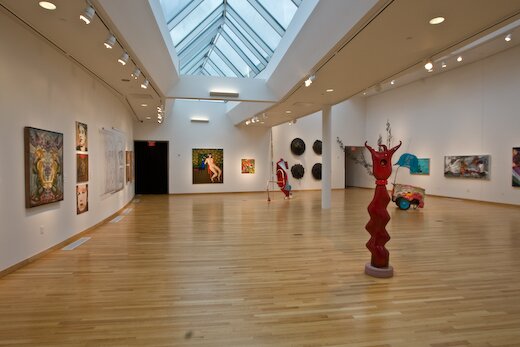
The group show at the Mexican American Cultural Center (run by Marfa Ballroom alum Simon Orta) was spacious and well-lit, with a lot of paintings, but also a nice sound sculpture by Justin Boyd outside the entrance:
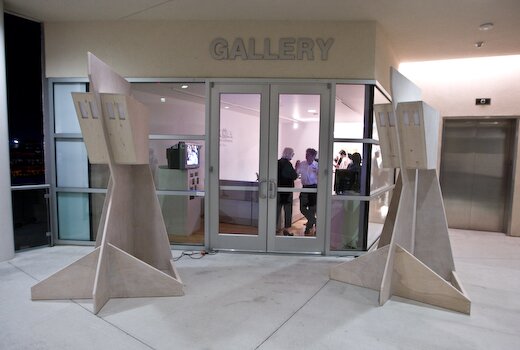
This sound sculpture plays recordings from the nearby river and powerlines to represent the flows of energy around the building — the physical sculpture references the architecture of the MACC itself. We didn’t get any photos from the opening of the group show at Women and Their Work because it was insanely crowded (and, searching on Flickr for “texas biennial 2009″, I get a bunch of photos… from the MACC, so maybe this wasn’t just a problem for us). Check out this slideshow at Women and Their Work’s website for some pics of the art.
The solo shows certainly felt more focused, and for the most part fit together better as a group than the group shows did. I’ll start with Jayne Lawrence, San Antonio artist and co-director of the Cactus Bra gallery, who represented the east (?) south* with a beautiful exhibit at MASS Gallery:

This is a huntress, although if you look closely you’ll see a large phallus between her legs — although Lawrence refers to all these creatures in the feminine, they are transgendered. This show consists of three human-size sculptures and a number of smaller drawings playing with ideas of mutation, a sort of biological collage across genders and species. Hunting and sexuality play big roles in these pieces as well, generating some really striking sex-and-death imagery. Here we have a creature who has been bitten in half by her lover, praying-mantis style:
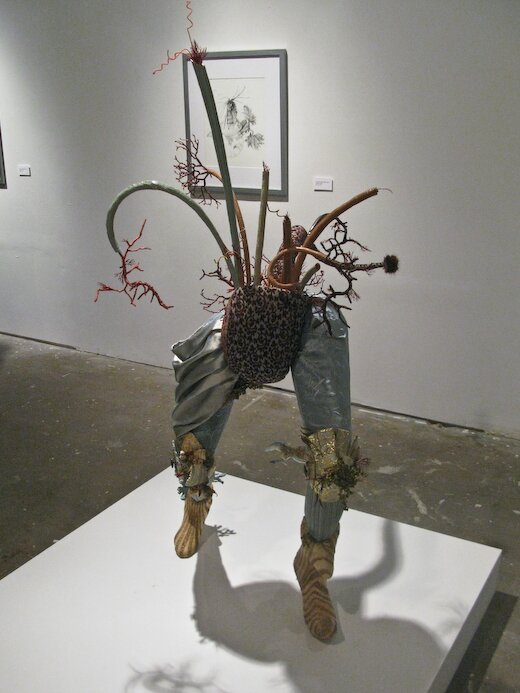
Lawrence combines textile, ceramic, plastic, papier mache, and other media in these highly textural and disorienting creatures. The drawings play with very similar organic themes, although some include architectural elements, hinting at a twisted Maker behind the scenes.
Lee Baxter Davis’ solo show at Pump Project consists of larger watercolors, embodying a mythology as dark as Lawrence’s, although of a somewhat less fantastical and more historicized nature:
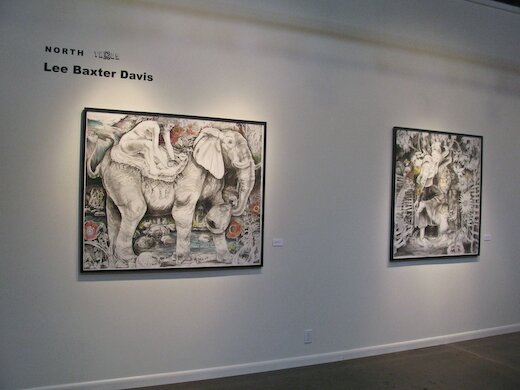
Strange narratives slip through the viewer’s fingers in this dense, magical-realist universe. It isn’t clear to me whether Davis is fictionalizing historical vignettes like Walton Ford, or spinning fresh tales out of a broad cultural experience. In any case, these works carry the tragic weight of a civilazation cutting into the wilderness, and fighting to stake out a stable place in the midst of chaos.
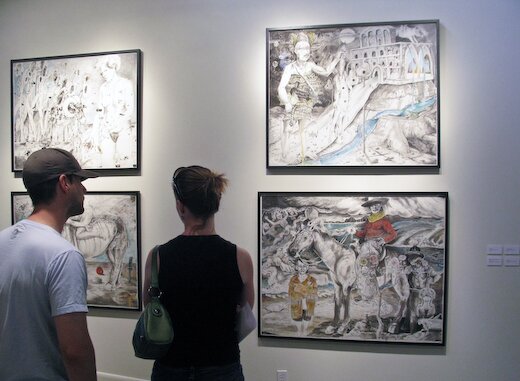
Moving on down to Big Medium, we encounter some large paintings that don’t have as much of the mythological or fantastical feel of Lawrence’s or Davis’ shows, but do play with the sexuality, violence and moral ambiguities contained there:

Representing the south east*, Vance’s beautifully rendered paintings from photographs depict psycho-sexual lesbian encounters, which, as Duncan points out in the catalog, are fraught with ambiguity. Themes of violence and humiliation are played against expressions of pleasure in ways that resist moral judgment. Vance is opening up private spaces that feel pure in their honesty, more direct than Lawrence’s fantasies or Davis’ narrative mazes. These scenes are radically intimate, without the weight of history or the complications of the world to get in the way of the pure relation.
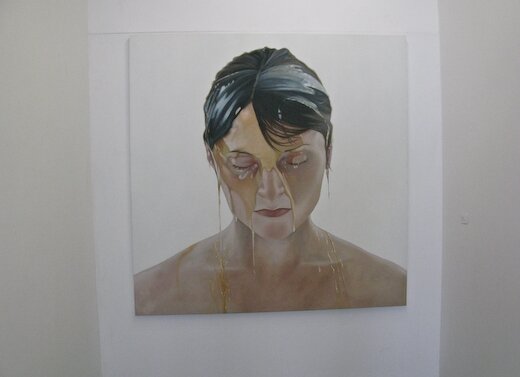
Finally we come to the West Texas show, Will Cannings at Okay Mountain. And here’s where the thematic development falls apart for me:
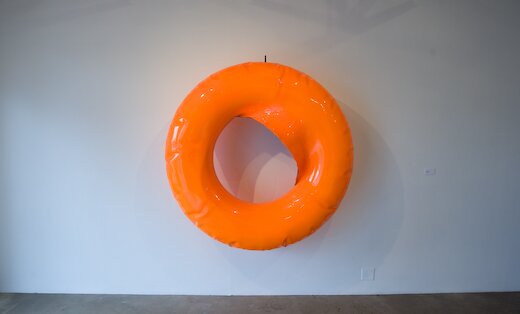
This is a steel sculpture inflated like plastic, or rather, over-inflated in this case, and burst along the inner seam. Personally, I couldn’t help thinking of Jeff Koons’ metal inflatable sculptures, although Michael Duncan was careful not mention those in the literature. It is largely a Pop affair, and it’s difficult to see how this show fits into the larger Biennial. The craftsmanship, though, is very tight, and Cannings put together a strong group that bridges the divide between Pop and Minimalism to some extent (one piece even directly references Brancusi):
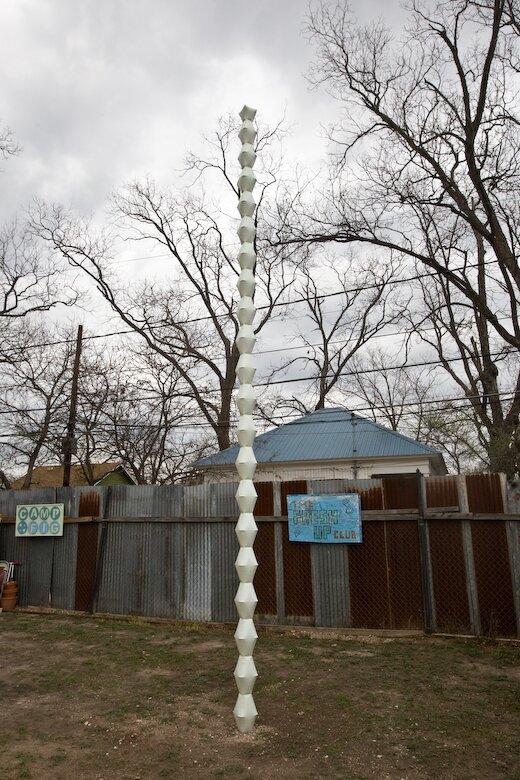
This post is getting pretty long, and I’ve got some other obligations this evening, so I’m going to save the outdoor pieces for another post. But in the meantime, I’ll leave you with some nice graffiti we stumbled on when we took a wrong turn on Shady Lane:

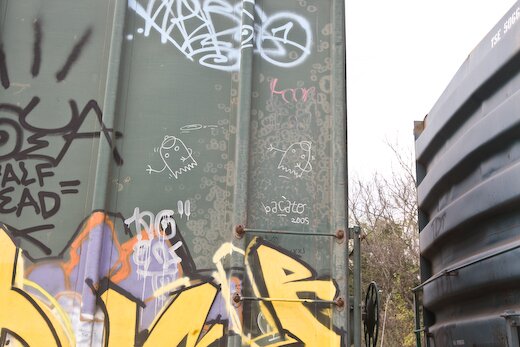
* Corrected thanks to commenter Salvador. That’s what I get for trusting the catalog…
Posted by aaron on 24 Feb 2009 | Tagged as: art paparazzi, music, sound art
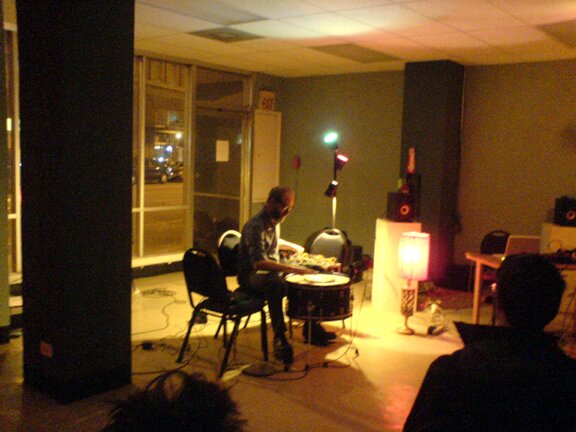
jason kahn performs at the former san antonio beauty college, saturday feb. 21st.
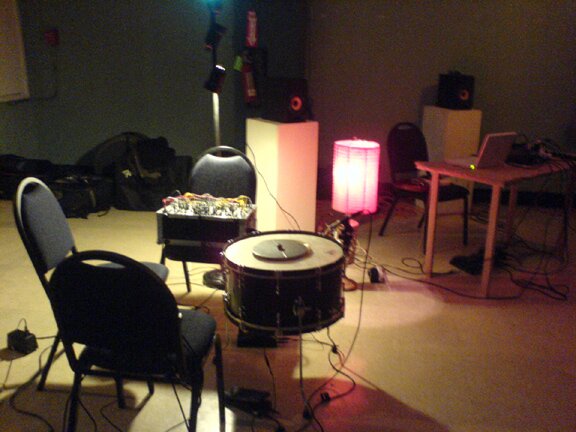
the stage, post-show.
apologies to annette krebs and chris cogburn, who were too blurry to post.
(photos: a famous cell phone photographer; lamps by saavedra + coltrane.)
Posted by ben on 19 Feb 2009 | Tagged as: architecture, music, public art, sound art
Posting has been light this week because I’ve been helping Jason Kahn set up his sound installation downtown on E Travis St (which is officially opening this Saturday). Kahn, a Zürich-based artist, has been working with sound as a material for years, in both performance and installation contexts. The idea is to activate existing spaces in a way that reveals unnoticed qualities, architecturally, environmentally, and perhaps socially.
In some senses “San Antonio Beauty College” has a strong relationship to Max Neuhaus’ Times Square piece; it is unmarked, and mostly invisible (if you look closely you’ll spot some small speakers); it uses abstract textural sounds that change as you move around them; its significance in the environment is meant to shift as other sounds move along the street. But socially, it feels very different. Times Square could hardly be further from this little piece of Travis street in terms of the amount of foot traffic and the socio-economic makeup of that traffic.
The block of Travis where he is installing this piece (titled “San Antonio Beauty College”) is between Broadway and Alamo. Although it is near the Express-News building, and around the corner from the popular Twin Sisters café, we’ve noticed that no one who has a home seems to walk on this little stretch of Travis Street. The space has become a kind of social eddy, as the employed flow down Pecan or Houston Streets.
As I’ve been publicizing this installation, which is meant to be experienced from the sidewalk in front of the building, I wonder how the existence of the piece will impact the social space it inhabits. Will the people who ordinarily walk down this street notice the subtle sonic textures that Kahn has engineered to be concealed and revealed as the city sounds ebb and flow? Will it attract visitors from nearby businesses, or just the occasional art observer? I’ve often wondered if we’re too limited in the ways that we think about using public art: a monument here, a mural there. Have we overlooked the power of small, almost unnoticeable environmental responses to shift the social landscape? I don’t expect this installation to have much impact in that regard, but if you see me sitting in Twin Sisters watching the sidewalk all day, you’ll know what I’m doing.
By the way, check our event listings to the right for more information on Jason Kahn’s performance this Saturday.
Posted by ben on 09 Feb 2009 | Tagged as: adventure day, public art, r.i.p., sound art
Last week I was surprised to learn of the passing of Max Neuhaus, and was a bit dismayed at the lack of coverage. The Houston Chronicle seemed to be the only paper covering the death of this important artist. But this morning I felt a bit better as the New York Times is out with their piece, and it’s a nice overview of his career.
Here, I thought I’d recount my first experience with a Neuhaus installation. I had been in New Hampshire to conduct the marriage of a good friend from college. On the way up, I learned of the death of my friend Alberto Mijangos, whose gallery I was running, and who in many senses had introduced me to art (I had attended his wedding in the Rothko Chapel at the age of five). Now I was headed back to San Antonio, a bit exhausted, trying not to think too much about this looming sadness.
My flight out of Manchester was delayed for hours. By the time it finally left, I had missed my connection in Newark, and the airline said it wasn’t their fault, so no hotel room. I decided not to pay for a hotel, to either sleep in the airport, or get in touch with a friend in the city. The one friend in New York I was able to reach was packing for a trip the next day, and didn’t have time for a visit. She helped me figure out how to get into Times Square, where I had heard there was a Max Neuhaus installation. By the time I made it into Times Square, it was about 11:30, still busy, but not too chaotic. I walked across the pedestrian islands until I heard a low ringing rumble flow up from the grates. As I stood there, transfixed in this invisible oasis, watching people and taxis wash over Broadway, I felt as if I was being enveloped by another world, which was really just an idea about perception. I rocked back and forth, listening as the sounds rippled and creased and rubbed, an infinitesimal percussion. Eventually, I made my way back the airport, and found a place on the floor to rest.
Posted by ben on 11 Aug 2008 | Tagged as: image & sound, music, performance art, sound art
I’m honored to be able to offer a recording of Crevice’s Infinity Asylum performance on this blog. This is a truly beautiful recording by one of the few groups in Texas to successfully bridge the music and art worlds. Infinity Asylum was part of an installation / performance at the Friedrich Building, a 500,000 square foot space on the east side of San Antonio, originally built to produce air conditioners. Tucked away in little nooks and crannies of the building were a number of installations (artists included: Dwayne Bohuslav, Christopher Biasiolli, Nate Cassie, Rae Culbert, and Jack Robbins). As visitors explored the space, Crevice played this “peaceful, hypnotic, cyclical music” (to quote from the original press release), which fell in and out of earshot. Many of the vocals you hear in the recording are samples of people talking about the installations, thus folding audience reaction into the performance. It was recorded on July 11, 2003.
Performers on this recording: Jeff DeCuir (guitar, processors), Jessica Barnett DeCuir (harmonica, percussion), John Navarro (theremin, processors), Bryan Stanchak (synth, bass), Stephen Reyna (guitar/e-bow).
Posted by ben on 01 Aug 2008 | Tagged as: acquisitions, arts organizations, music, public art, sound art
Now that the first batch of artists commissioned for the Riverwalk expansion has been announced (there will be others as the expansion proceeds), I wanted to highlight the most historically significant artist selected, and the most interesting one to me personally: Bill Fontana. I missed the reception for him at Artpace earlier this week, so if you attended feel free to let us know how it went in comments.
Fontana studied at the New School for Social Research in New York, graduating with a B.A. in 1970. From 1972 to 1978 Fontana showed several sound sculptures in galleries, but it was in 1976 that he began producing the large-scale sound installations for which he has become known. Fontana’s work follows directly from the thought of John Cage, who was the most prominent inspiration for the early sound artists:
I began in the late 60s, when I was a student in New York and had taken a John Cage course at the New School, and was really beginning to experiment a lot with sound, found sound, recording sound and playback. The very first sound installation I made was in the very early seventies called Sound Sculpture With Resonators, in which I took some resonant objects, like large bottles that someone had made wine in, and placed them on the roof of a building in New York and put little acoustic microphones in them, and transmitted the sounds to the gallery space below. So you’d hear the object which became this very musical, filtered noise of the city. That’s probably one of the earliest works for me. [source]
In his work, Fontana chose to focus on the idea of musicality being a state of mind more than a characteristic of the sounds themselves:
I began my artistic career as a composer. What really began to interest me was not so much the music that I could write, but the states of mind I would experience when I felt musical enough to compose. In those moments, when I became musical, all the sounds around me also became musical. [source]
One thing that has distinguished Fontana from other sound artists (such as Max Neuhaus) is that throughout his career he has kept working with ambient sound, and never moved into electronically generated sound. He has often worked with types of sound displacement in installations such as “Sound Island” (1994) which allowed people at the Arc de Triomphe in Paris to hear ambient sounds from the coast of Normandy and from various locations in the city. This work, which is in a sense extremely minimal, has a number of historical and philosophical implications.
In “Harmonic Bridge,” on the other hand, Fontana deals not simply with displacement of sound, but with revealing the relationship between environmental sounds and the acoustic properties of objects within those environments. By applying microphones the London Millenium Foot Bridge, and amplifying sounds “hidden” in the bridge, Fontana reveals a “music” created from wind, foot traffic, etc., engaging with the resonant structure of the bridge itself. As with “Sound Island,” this piece has a number of social implications lurking just below the surface. A recording of “Harmonic Bridge” can be heard below.
Posted by ben on 25 Jul 2008 | Tagged as: adventure day, music, renegade performances, sound art
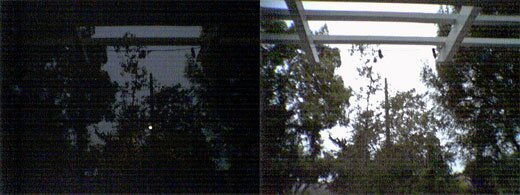
Steve Roden posts on a gig canceled, then rescheduled with only the Sun as audience. Be sure to listen to the audio linked at the bottom of his post.
Posted by ben on 07 Apr 2008 | Tagged as: music, rock!, sound art
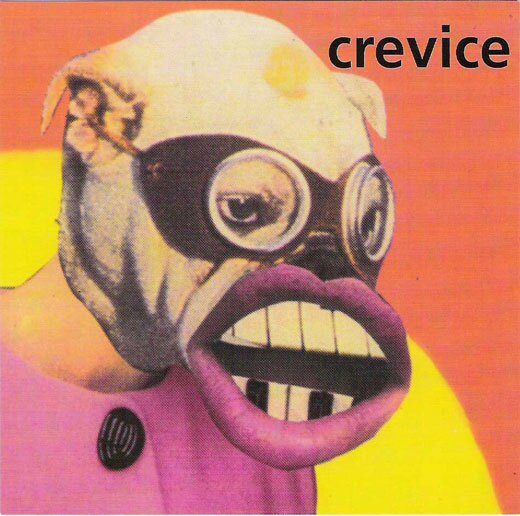
Mutant Sounds, one of the best underground music blogs out there, just posted a couple of albums by my all-time favorite San Antonio band, Crevice. These albums are long out of print, so if you are interested in learning just how weird San Antonio can get, grab these gems while you can. From the Mutant Sounds write-up:
Here’s a great offer by another friend of the blog, Uncle Buzz, aka Crevice. Wonderful space/cosmic, freaked out electronic compositions, amongst the best of its kind. The 1st one is a 71 minutes psych/cosmic electronic explorations lost in the depths of outer space. The second one consists of 4 log meditative sonic cosmic compositions, with eastern feeling sometimes, not far from the very early Tangerine Dream/ Kluster attempts.
Posted by ben on 05 Mar 2008 | Tagged as: music, sound art
Following up on my post earlier this week about the history of the Wilhelm Scream, here’s a video about one of the most ubiquitous samples in contemporary music — the Amen Break. Like the Wilhelm Scream, the Amen Break has been woven into an astounding number of otherwise unrelated works from a wide range of styles and genres. Towards the end, this video also deals with the copyright issues surrounding sampling and appropriation art, and while it doesn’t really break any new ground in this respect, it may be of interest to those who haven’t spent much time with these issues.
Posted by ben on 03 Mar 2008 | Tagged as: performance art, sound art, tv, video/film
Some enterprising movie nerds have traced the history of a stock scream sound effect now known as the “Wilhelm Scream” (the original title in the Warner sound effects archives was “Man Being Eaten by Alligator”). The sound effect has been used in over 75 movies, including all the Star Wars and Indiana Jones movies, as well as a number of TV shows and even video games.
This is an interesting counterpoint to a performance by Chris Kubick and Anne Walsh at UTSA last spring, which paired movie sound effects with their titles from the stock sound effect catalogs. Kubick and Walsh built collections of comparable sounds such as various recordings of ringing bells or galloping horses and created a program that projected the name of each sound effect as it was being played, showing the huge variety of linguistic associations that can be made with very similar sounds.
(via The Plank)
Posted by ben on 11 Feb 2008 | Tagged as: music, performance art, silliness, sound art
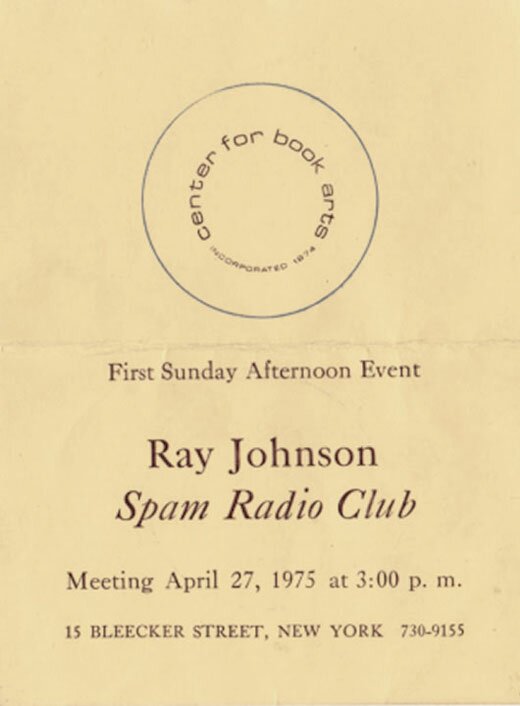
That’s still another thing about the Correspondence School, it’s not just the letters, the postcards, the drawings, the poems, it’s also the New York Correspondence School objects. The Spam radio, for example, was a radio in the shape of a Spam can, which had a little handle on it, it was a thing the Spam Corporation made one year as an advertising gimmick. It was something they gave to people, and you could go to the beach with your Spam radio, and play your radio on the beach, it was a little radio inside of a Spam can, and I didn’t really treasure it very much so I gave it to Jim Bohn.
…
But to get back to that radio, I gave it to Jim Bohn — which is BOHN and not BONE — and the following week he was in Soho walking around with his wife and carrying the Spam radio as a kind of prize trophy. He was taking it out for a walk, and the minute I saw him with it I realized that he had given it some kind of notoriety and importance, and I was intensely jealous that he was walking around with the Spam radio and that I hadn’t thought of walking around with a Spam radio, like the time I had once walked around with the head of Candy Darling in a plastic bag. So still another week later, I was in Soho again and went to the supermarket and bought a real can of Spam and put a little handle on it, and then I was walking around with that.
Posted by ben on 24 Jan 2008 | Tagged as: music, responses/reviews, sound art, video/film
Argentine artist Jorge Macchi has been all over South Texas lately — he was a resident at Artpace in 2005, he currently has a piece in the Triangle Project Space’s Standing on one foot, and the Blanton is showing Anatomy of Melancholy, his first “comprehensive U.S. exhibition,” through March 16.
As I wandered through the Blanton exhibit, I was reminded of the scene in The Breakfast Club when Allison (the “psycho” girl) puts on makeup and everyone realizes she’s a fox. Jorge Macchi has put in a lot of effort giving Fluxus a shave and a haircut, and what do you know, it fits very nicely into a standard gallery format. Macchi’s Caja de música, for instance, draws on the chance operations that ’60s experimentalists picked up from John Cage. Taking video of cars on a 5-lane highway, Macchi assigns a musical note to each lane, and as a car enters the frame the note corresponding to the lane it is in plays, creating a kind of randomized music box (you can watch this video on his site).

He’s also very fond of finding the edges of things, the demarcations, and focusing on those rather than the intended content of an appropriated work. For instance, at his Artpace residency, he took the final moments of several old movies and created video loops of the “The End” sequences. In an analogous move at the Blanton show, he cuts everything out of a map except the graveyards. These pieces draw our attention to the liminal moments, the insecurity of transition. Despite the summoning of these precarious situations, though, Macchi’s work feels very comfortable. He’s taken the ideas pioneered by Dada and Fluxus artists, art based on the awkward and the random, smoothed out the edges and made it feel very safe within the white walls of the museum.
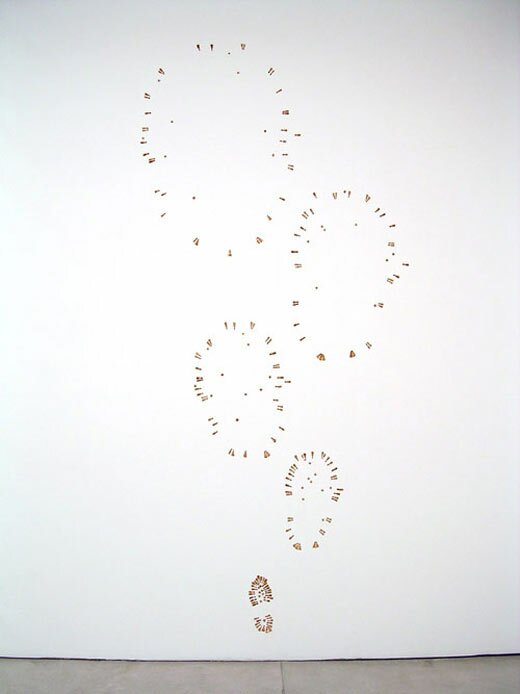
There are some very elegant pieces in the Blanton show, including Caja de música, and Fuegos de artificio, a piece in which footprints made of soil expand outward on the wall, progressively losing their form like ripples on a pond. This is a concise and beautiful statement about the impact we have on the world as we move through it, bringing with us the dirt of another place, which gradually loses the significance of having come from our shoes.
But I’m left wondering whether the ideas Macchi draws from are best expressed with the sort of finesse and refinement he brings to them. Maybe the chance operations of Arp, Cage, Maciunas and all the others are better left in a raw form. Maybe Allison was hot without the makeup.
Posted by ben on 08 Dec 2007 | Tagged as: essays, music, r.i.p., responses/reviews, sound art
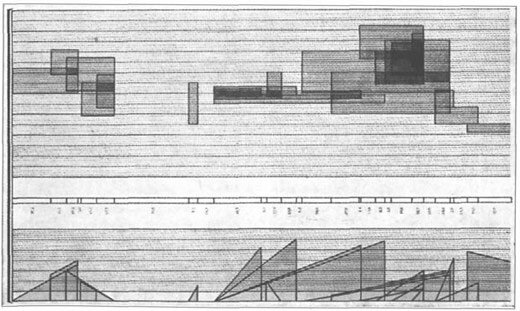
On the news of Stockhausen’s death, it may be worth reading this long essay on his work, which is still often misunderstood. This brief quote encapsulates some of the main ideas of the essay (by Jean-Claude Eloy):
The splendid success of the overall conception, general organization and production of “Zyklus” still do not always allow for the percussions to truly express their life and demonstrate all of their rich potential. On this matter, a work such as “Mikrophonie I” opens up surprising vistas and breaks down all barriers. The rich, but single, source for the whole work (the large tam-tam) is allowed ample time to “share” its multiple metamorphoses of tones, attacks, and resonances. Once again, with such a work, Stockhausen has shown himself to be a frontrunner, the boldest of all.
Throughout his work, Stockhausen’s dialectical personality is express by this double thrust, one rotating, the other ascending. One the one hand, he is truly audacious in his conceptual work and he knows how to impose a (sometimes “abstract”) form of thinking on musical material. And on the other hand, he possesses a very open sensitivity that studies material, listens to sounds created in the studio, analyzes their hidden pulsations, all to extract new meaning, go a step further and push the material forward.
Stockhausen’s double success in the two worlds of instrumental and vocal music – sound material that is already laden with history and acquired habits – as in the new realm of exploration of electro-acoustic technologies (a unique case in our times), can be understood by the presence of this dialectic that is constantly criss-crossing and circulating between two poles: from conception to material and from material to conception. Although ostensibly contradictory, these two poles are, in fact, complementary.
[Image above is a page from the score of Stockhausen's 1954 composition Studie II]
UPDATE: I decided to upload an MP3 of Stockhausen’s groundbreaking 1956 composition, Gesang der Junglinge. You can read more about this piece here. Enjoy.
Posted by ben on 17 Oct 2007 | Tagged as: poetry, sound art
I’ve had the good fortune to stumble on a couple of great sites in the past couple of days. Sound artist Steve Roden’s blog (”basically a space to share ‘the collection’, much of which serves as inspiration for my work…”), which contains lots of interesting artistic tidbits, including this version of “Listen to the Mockingbird” by Fiddlin “Red” Herron.
And also The Page, a site cataloging links to new poetry, essays about poetry, and some other literary nuggets thrown in for variety. Enjoy.
Posted by ben on 28 Sep 2007 | Tagged as: celebrity sightings, music, performance art, renegade performances, sound art
Posted by ben on 27 Sep 2007 | Tagged as: sound art
For those of you who enjoyed Kevin Concannon’s lecture on Yoko & John last night, check in with this article he wrote on sound art: Cut and Paste: Collage and the Art of Sound.
Posted by michelle on 24 Aug 2007 | Tagged as: art paparazzi, responses/reviews, sound art
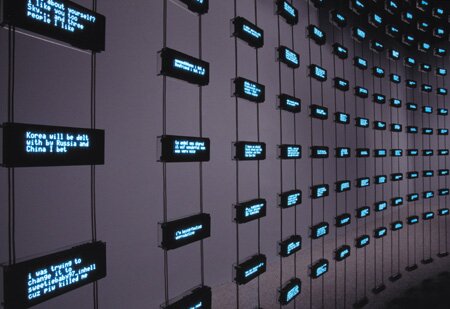
Mark Hansen and Ben Rubin sift through new media with a sharp and calculating statistician’s sensibility. The result, currently at Yerba Buena, leaves audiences reeling with the brainiac implications involved in such a complicated, perfectly orchestrated piece of musical, LED sublimeness. Here’s an example of the listening post in action at the Whitney in 2002.
Posted by ben on 17 Aug 2007 | Tagged as: essays, music, sound art
Andrew Waggoner sends a 3,000 word battle cry into the ether, begging us to beat back the “colonization of silence” before it’s too late. He juxtaposes complaints about the overabundance of music in modern life (music while we shop; music while we drive; music while we wait for the AT&T customer service rep to answer our calls) with praise for the powerful use of silence by composers such as Webern and Morton Feldman. I can’t help but wonder if the solution to this problem is as simple as replacing Muzak with, say, the Lovely Music catalog.
On the other hand, here’s a video of John Cage . He, too, waxes eloquent on the limitations of “what we call music” (does this include Feldman?), and the power of silence. And somehow, in this 4-minute video, Cage seems to say more than Wagonner can pack into 3,000 words. You get the feeling that Cage has absorbed silence, that he embodies silence, while Wagonner pines away for it.
PS. Here’s another discussion of silence in the context of poetry for those that missed it.
Posted by ben on 19 Jul 2007 | Tagged as: adventure day, music, rock!, sound art
Emvergeoning’s NYC correspondent fvc sent the following account of a day on which mushrooms threaded together Max Neuhaus’ Times Square sound installation and the Boredoms’ recent “77 Boadrum” concert in a park under the Brooklyn Bridge. As luck would have it, I happened to get ahold of a recording of this very concert through another friend. Follow the link at the bottom of the post to download the MP3. Photos provided by generous Flickr users.
Several weeks ago some friends were sitting around at my apartment on a hot lazy sunday afternoon. They wanted some weed so they called a guy who sent his runner over with a briefcase of pot, hash, mushrooms, pills and powders, each in at least 2 or 3 varieties. The dealer even had a neat “menu” with descriptions of everything for sale. Drugs are a very professional service industry in Manhattan, if you have the right numbers.
Everyone bought some weed and then the dealer gave a 20 sided die to J — who called the number three and then tossed the die — a three. So he won a bag of mushrooms. After the sun set and we had gone to go look for a place to eat dinner, the mushrooms where left behind. They sat around my apartment for almost a month.
Posted by ben on 14 May 2007 | Tagged as: music, sound art, video/film
This film was produced for the Phillips Pavilion at the 1958 World’s Fair in Brussels by Le Corbusier, Edgar Varèse, and Iannis Xenakis. It was shown in an exhibition space (described more fully below) which included 425 speakers, so that the sounds could follow complex routes through the space. Watching it on YouTube is a far cry from the intended experience, but is rewarding nonetheless. For a more complete examination of this ground-breaking project, check out Marc Treib’s “.”
“Poème électronique” is the first electronic-spatial environment to combine architecture, film, light and music to a total experience made to function in time and space. Under the direction of Le Corbusier, Iannis Xenakis’ concept and geometry designed the World’s Fair exhibition space adhering to mathematical functions. Edgar Varèse composed the both concrete and vocal music which enhanced dynamic, light and image projections conceived by Le Corbusier. Varèse’s work had always sought the abstract and, in part, visually inspired concepts of form and spatial movements. Among other elements for “Poème électronique” he used machine noises, transported piano chords, filtered choir and solo voices, and synthetic tone colorings. With the help of the advanced technical means made available through the Phillips Pavilion, the sounds of this composition for tape recorder could wander throughout the space on highly complex routes.
“The Philips Pavilion presented a collage liturgy for twentieth-century humankind, dependent on electricity instead of daylight and on virtual perspectives in place of terrestrial views.” — Marc Treib,
Posted by ben on 16 Apr 2007 | Tagged as: music, sound art, video/film
I just discovered Piotr Kamler while searching YouTube for work by Bernard Parmegiani (Parmegiani scored some of Kamler’s films). Kamler’s films are a kind of lyrical, abstract take on science fiction, with stunning animation sequences executed in a wide variety of media.
Here’s Une Mission Ephemere (1993; scored by Parmegiani):
Also check out (scored by Francois Bayle). Here’s a good discussion of the work of Kamler and his contemporaries. And if you like the soundtrack: two Parmegiani albums are available for download on Mutant Sounds right now.
Posted by ben on 01 Apr 2007 | Tagged as: art paparazzi, performance art, responses/reviews, sound art, video/film
Justin Parr took some cell phone video of Chris Kubick & Anne Walsh’s recent performance at UTSA, A Thousand Years of Sound Effects (below). It was a three-part performance, with each part focusing on a specific kind of sound effect. In all three parts, the performance was an interaction between the artists and a SuperCollider program designed to play sound effects in response to input parameters, with a certain amount of randomness thrown in. The first part, which was performed by Kubick alone, involved less physical performance than the others. This piece was a collection of bell sound effects, which were played as Kubick interacted with the program through the keyboard and other inputs. For the next piece, Kubick and Walsh both interacted with the computer by stepping on pressure sensitive inputs placed on the floor. The sounds used in this performance were of horses galloping or walking. The final piece used sound effects of people clapping, and the artists interacted with the computer by clapping into a microphone (you can watch a segment of this piece below).
The program also generated video to accompany the sounds. For most of the performance, the program displayed the name of the audio file(s) being played, giving a glimpse into the strange world of sound effect naming conventions. Many of the effects had titles such as “Fairy Belching” or “Claps of old powerful men, white.” Sometimes the titles referred to the location of the recording, other times to more abstract characteristics. The interaction between these sounds, which have no context and therefore a wide variety of potential meanings, and their titles, which at times provided absurdly specific cultural contexts, was of particular interest to the artists. During the horse performance, some images of horses were displayed rather than the titles of the sound effects. The images were fairly crude and had a sort of clip-arty feel.
The performance was rough, and the artists are clearly just beginning to explore the potential of this concept (in fact, this was the first time that the pieces have been performed in public). The work does, however, have a lot of potential, and it will be interesting to see how they develop these performances in the future.
Posted by justin on 21 Mar 2007 | Tagged as: adventure day, announcements, in yo face, performance art, silliness, sneak peeks, sound art, upcoming events, video/film
Potter-Belmar labs, among others will be part of the March 31st bike gang summit starting at 1906 south flores. The ride will wind through downtown and other parts of the city with stops in all manner of strange locale. I have just gotten word that at some juncture we will be finding a giant renegade video projection..
Come up with a good gang name and theme and dress it up! this is going to be really really really fun. (really!)
The Beto Gonzales designed flyer.
